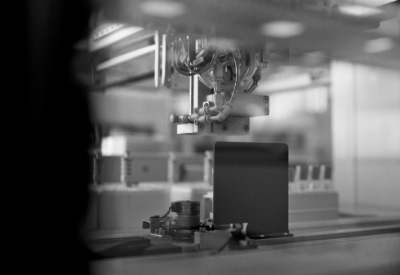December 2022 | News
Creating Helpful Incentives to Produce Semiconductors (CHIPS)
Electronic devices have been getting smarter and smaller for as long as they have been around. The first computer (ENIAC) was 27 tons and took up 1,800 square feet. Now we carry handheld devices with hundreds of millions of times the processing power everywhere we go. With the influx of microelectronic devices and semiconductors being developed worldwide, it appears this trend will only continue.
On August 9, 2022, President Biden signed the CHIPS and Science Act into law. This CHIPS Act news comes as an overdue win for the U.S. microelectronics industry.
What Is the CHIPS Act?
In total, the CHIPS and Science Act provides $280 billion to science-related research and development. Around $52 billion of that is dedicated to improving the domestic production of semiconductors and other materials.
CHIPS stands for “Creating Helpful Incentives to Produce Semiconductors” and is focused on reclaiming the semiconductor supply chain from foreign countries that have dominated it for many years. The U.S. hopes to make this happen through the use of research and development (R&D) programs, investment tax credits, and centralized committees responsible for funding allocation.
Importance of the CHIPS Act
The CHIPS Act is crucial in the context of manufacturing, national security, and economics. The funding from this law will help the U.S. reclaim control of its semiconductor—and ultimately microelectronic device—supply chain.
Microelectronic devices form the foundation for today’s technological innovations. Cars, computers, household appliances, and complex defense systems all rely on small electrical components like semiconductors, integrated circuits, and sensors to function.
As of 2021, the chief exports of the U.S. are mineral fuels, machinery, and electrical equipment. The semiconductor industry, however, is primarily supplied by regions of Southeast Asia, such as China, Singapore, and Japan.
Although the U.S. invented semiconductors, we now only produce around 10% of the world’s supply. This is no small industry, and it’s certainly not inexpensive. The CHIPS Act aims to reposition the U.S. as a frontrunner in the microelectronics field.
Reinforcing the Supply Chain
The CHIPS Act addresses a variety of challenges that were present well before the last few years. However, the impact of the COVID-19 pandemic on global supply chains has become a driving force to secure microelectronic device production. The countries we relied on for semiconductors and other electronic components were unable to deliver what we needed. This was a wake-up call not only to the clients who weren’t getting their products but also to the U.S. government as a whole.
Funding from the CHIPS Act will help develop a domestic microelectronics supply chain that can be closely regulated.
What CHIPS Means for City Labs
CHIPS will provide support to companies of all sizes depending on their contributions to the microelectronic device supply chain. City Labs makes betavoltaic power sources composed of semiconductors that can be used to power semiconductor chips and other small microelectronic devices.
This massive boost to the microelectronics industry means potential subsidies for City Labs’ expenses. It also gives companies an increased incentive to incorporate radioisotopes and nuclear batteries into technological development efforts.
Some tech giants have already made announcements of huge investments with the signing of the CHIPS Act. Intel was already constructing a new location in Ohio and has stated that the new legislation may allow them to quintuple their initial investment. Micron is planning to spend $40 billion on manufacturing facilities in the U.S. through 2030.
Anyone and everyone in the field of microelectronics, semiconductors, or other related topics should browse the CHIPS Act to see what it holds.
CHIPS Act Summary
Our goal in the following content is to help you get a better understanding of the evolving landscape. You can read the full CHIPS Act here.
Workforce and Development
Now that the CHIPS Act has been passed, industry labor demands will increase substantially. Workforce needs could more than double over the next few years, leaving microelectronics companies in a difficult position if there is not an influx of training.
A significant portion of the bill is dedicated to funding R&D programs nationwide. From FY22 to FY26, the Subcommittee on Microelectronics Leadership will spend $11 billion developing workforce training programs.
The U.S. government hopes that curriculum development, public outreach, labor groups, shared training, and partnerships between degree institutions will lead to a more standardized microelectronics workforce.
Increased Emphasis on Radioactive Isotopes
More and more devices are beginning to use relatively benign radioactive isotopes as power sources. The CHIPS Act delegates money specifically to R&D programs that focus on sustainable energy science. Nuclear matter and low-dose radiation are areas of interest on the clean energy front.
According to Section 10106, the CHIPS Act authorizes the construction of a processing facility which will make radioisotopes for radiochemical processing needs.
Refundable Credit for Secure Microelectronics Companies
On the business side of things, the CHIPS Act recognizes that there are already many valuable efforts in place. Money has been set aside to grant refundable tax credits to companies that are already working towards securing the microelectronics supply chain.
There is a 25% investment tax credit for companies that manufacture semiconductors or equipment necessary for semiconductors. This means investors can receive 25% of what they put into a semiconductor company as a tax refund or direct pay.
Incentives like this help to bolster the growth of innovative companies and push the industry to new achievements.
Other CHIPS Act Actions
Some other key points of the CHIPS Act which may directly impact City Labs are listed below.
- $2 billion for a CHIPS for America Defense Fund that will lead to industry input on innovations in defense microelectronics
- $150 million each year for acquiring and commercializing scientific resources in the $1-20 million range
- Gives National Institute of Standards and Technology (NIST) more control over the private entities they choose to partner with for R&D activities
- Creates a small business voucher program for sending employees to skills training and demonstrations at national laboratories
- Directs NASA to prioritize radioisotopes for space nuclear power and continue their research of nuclear propulsion technology for the 2030 mission to Mars
Though the CHIPS Act is not the be-all-end-all of semiconductor supply line security, it is a significant step in the right direction. It will likely take several years before the U.S. truly starts to feel the impacts of this revolutionary legislation.
CHIPS Funding Eligibility
To receive the R&D grants from the money set aside for the CHIPS Act, eligible companies will need to send in a proposal to the CHIPS Program Office. The following eligibility criteria must be met before a company’s proposal will be looked at.
The company must have the following:
- A documented interest in “constructing, expanding, or modernizing a facility”
- Been offered an incentive for the program
- Committed to worker and community investments
- Secured commitments to provide workforce training from training and regional education centers
- An executable plan to sustain the facility with no additional assistance
- An executable plan to help mitigate relevant semiconductor supply chain risks
Beyond meeting these conditions, a company’s proposal must also stand out from the other applicants. The CHIPS Program Office will prioritize applications from companies that show the following characteristics.
The company:
- Encourages collaboration between different levels of the supply chain (e.g., upstream and downstream partners)
- Addresses supply chain risks to do with visibility, transportation, disruptions, and other security considerations
- Follows standards and guidelines on information security
- Includes both state and local incentive packages that foster industry growth in the community
- Moves quickly and demonstrates a wealth of local or regional support
- Provides “effective and creative workforce solutions” at a large enough scale to meet industry demands
- Partners with small and underrepresented businesses in their construction and production efforts
- Offers project-specific, company-level financial data outlining the use of the CHIPS funding
- Provides an executable plan to fund the business without any help from the CHIPS investment if necessary
Just because your company does not fulfill these requirements does not mean you will not be eligible for a grant of some kind. However, you are more likely to stand out among other applicants and receive larger amounts if you do meet the above criteria.
Manufacturing Secure Microelectronics Domestically
The CHIPS Act is important because it helps us bring microelectronic device production to the U.S., but why is that important?
Beyond centralizing the supply chain to reduce dependence on foreign countries, there is also an aspect of national security in having control over our device components. We have less control over the quality of microelectronics from other countries and cannot monitor the manufacturing process.
There may be programs or devices within imported electronics that track an individual’s actions or provide information to a third party. Depending on the data that is relayed to the manufacturer, this can be seen as a threat to national security.
Learn More About City Labs’ Technology
Here at City Labs, our batteries harness the hydrogen isotope tritium to produce long-term low-energy power sources for microelectronic devices and small electronic components.
If you’re interested in learning more about how our products could benefit your scientific or commercial efforts, reach out to schedule a meeting with our CEO, Peter Cabauy.
The batteries we make can last for more than 20 years and output a steady, predictable charge throughout. We are constantly working to improve our technology for our partners and find new ways to harness nuclear energy for practical applications.






